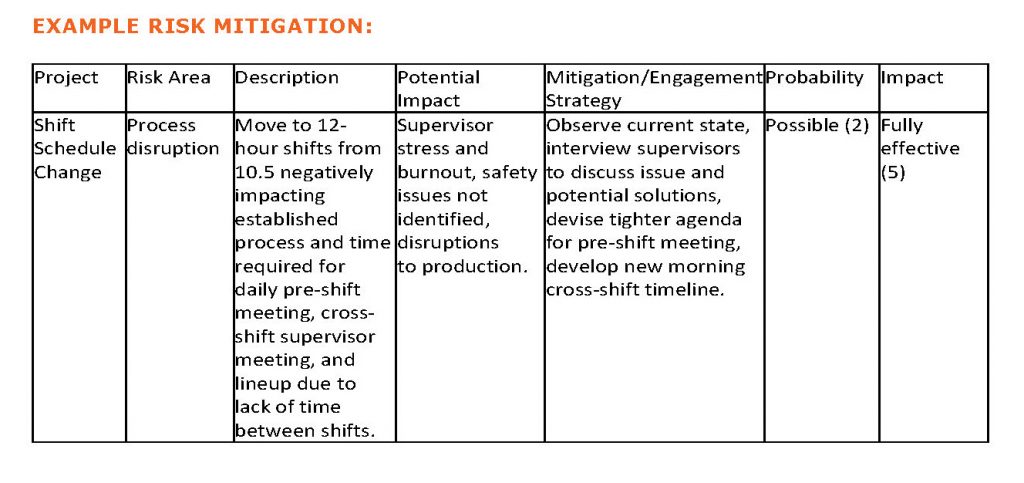Problem Statement
On September 18, 2017, Hemlo’s underground (UG) mining operation moved from 10.5-hour shifts with no shift on the Sunday day shift to 12-hour shifts, bringing UG operations in line with the open pit and the mill.
The move entailed a significant change to the operation and various processes, as well as to the crews and their work/life balance, etc. A number of risks were identified:
- Productivity dip
- Safety issues
- Employee resistance,
- inability/unwillingness to adapt to new changes
- Failure to effectively communicate need/lack of trust in management motives
- Negative impact to morale/culture external scrutiny (media, stakeholder, communities of interest)
Goal
Barrick’s Hemlo operation employs approximately 500 direct employees and 200 contractors. The mine is slated to run until at least 2021. Feasibility studies are underway to identify considerations involved in extending life of the mine to 2031. A number of productivity initiatives and improvements are underway to provide Hemlo with the means to lower the cut-off grade and increase the ore reserve, in a safe and sustainable manner. If results are positive, Hemlo could remain a key employer to local communities for years to come.
Expansion of the underground shift schedule to 12-hour shifts is a key component of these improvements, which along with Autonomous Mucking and technological improvements, will combine to increase productivity and lower our cost per tonne based on fixed costs.
The shift schedule change increases production time from 120 hours to 168 hours, and conservative estimates put the resulting productivity increase at 14% by the end of 2017 through the shift change initiative alone.
Result
Pacers (people who work for PACE) pride themselves in integrating themselves with the workforce and connecting with those close to the action. We helped manage change through assessment of both workflow and staff concerns about the shift change ahead of implementation and in real time during the changeover, and effective communication of the benefits and collection of feedback, significantly mitigated risk to the organization. We ensured that the right message reached the right individuals by leveraging all of the formal and informal communication pathways and platforms most effectively.
On September 18, 2017, Hemlo’s underground (UG) mining operation moved from 10.5-hour shifts with no shift Sunday day shift, to 12-hour shifts, bringing UG operations in line with the open pit and the mill.
ISSUE:
The move entailed a significant change to the operation and various processes, as well as to the crews and their work/life balance, etc. A number of risks were identified:
- Productivity dip
- Safety issues
- Employee resistance,
- inability/unwillingness to adapt to new changes
- Failure to effectively communicate need/lack of trust in management motives
- Negative impact to morale/culture External scrutiny (media, stakeholder, communities of interest)
BACKGROUND
Barrick’s Hemlo operation employs
approximately 500 direct employees and 200 contractors. The mine is slated to run until at least 2021. Feasibility studies are underway to identify considerations involved in extending life of the mine to 2031. A number of productivity initiatives and improvements are underway to provide Hemlo with the means to lower the cut-off grade and increase the ore reserve, in a safe and sustainable manner. If results are positive, Hemlo could remain a key employer to local communities for years to come.
Expansion of the underground shift schedule to 12-hour shifts is a key component of these improvements, which along with Autonomous Mucking and technological improvements, will combine to increase productivity and lower our cost per tonne based on fixed costs.
The shift schedule change increases production time from 120 hours to 168 hours, and conservative estimates put the resulting productivity increase at 14% by the end of 2017 through the shift change initiative alone.
VALUE PROPOSITION:
Pacers (people who work for PACE) pride themselves in integrating themselves with the workforce and connecting with those close to the action. We helped manage change through assessment of both workflow and staff concerns about the shift change ahead of implementation and in real time during the changeover, and effective communication of the benefits and collection of feedback, significantly mitigated risk to the organization. We ensured that the right message reached the right individuals by leveraging all of the formal and informal communication pathways and platforms most effectively.
HOW IT WAS ACCOMPLISHED:
Assessment of time to task underground and development of new shift cards Assessment of supervisor pre-shift process Conduct BrainWrite questionnaires with crews to identify key areas of concern and development of Question and Answer documents for distribution to crews based on concerns outlined Development of key messages for General Foremen and supervisors for use in lineups before and during implementation highlighting benefits Development and use of communication tools (memos, e-mails, newsletter articles)
SAMPLE VISUAL AID

Development of visual tools (posters, newsletter graphic) Observation, feedback gathering and adjustment during implementation
SAMPLE Q&A:
Q: What about the effect on families with parents now working longer shifts?
A: The new schedule is expected to provide more balance and consistency. There will be no short change from days to nights during a run of shifts. It allows for two full weekends off per month and 27 extra days off per year. The underground operation will still close for statutory holidays like Easter and Christmas. Families will no doubt adjust as they become accustomed to the new schedule.
EXAMPLE RISK MITIGATION:

CONCLUSION:
The shift change has been implemented and early feedback is positive. PACE has a baseline from which to measure and gauge crew and supervisor reaction, and will continue to monitor and assess crews and processes to ensure communications remain effective and adjust as necessary.